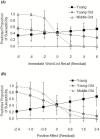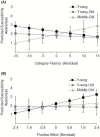Uncovering Susceptibility Risk to Online Deception in Aging
- PMID: 29669133
- PMCID: PMC8921760
- DOI: 10.1093/geronb/gby036
Uncovering Susceptibility Risk to Online Deception in Aging
Abstract
Objectives: Fraud in the aged is an emerging public health problem. An increasingly common form of deception is conducted online. However, identification of cognitive and socioemotional risk factors has not been undertaken yet. In this endeavor, this study extended previous work suggesting age effects on susceptibility to online deception.
Methods: Susceptibility was operationalized as clicking on the link in simulated spear-phishing emails that young (18-37 years), young-old (62-74 years), and middle-old (75-89 years) Internet users received, without knowing that the emails were part of the study. Participants also indicated for a set of spear-phishing emails how likely they would click on the embedded link (susceptibility awareness) and completed cognitive and socioemotional measures to determine susceptibility risk profiles.
Results: Higher susceptibility was associated with lower short-term episodic memory in middle-old users and with lower positive affect in young-old and middle-old users. Greater susceptibility awareness was associated with better verbal fluency in middle-old users and with greater positive affect in young and middle-old users.
Discussion: Short-term memory, verbal fluency, and positive affect in middle-old age may contribute to resilience against online spear-phishing attacks. These results inform mechanisms of online fraud susceptibility and real-life decision-supportive interventions toward fraud risk reduction in aging.
Keywords: Affect; Cognition; Decision making; Online; Spear phishing.
© The Author(s) 2018. Published by Oxford University Press on behalf of The Gerontological Society of America. All rights reserved. For permissions, please e-mail: journals.permissions@oup.com.
Figures



References
-
- Anderson, K. (2013). Consumer Fraud in the United States, 2011. The Third FTC Survey. Staff Report of the Bureau of Economics. Washington, DC: Federal Trade Commission.
-
- Baltes, P. B., & Mayer, K. U. (1999). The Berlin aging study: Aging from 70 to 100. P. B. Baltes & K. U. Mayer (Eds.). Cambridge: Cambridge University Press.
-
- Brandt, J., Spencer, M., & Folstein, M. (1988). The telephone interview for cognitive status. Neuropsychiatry, Neuropsychology, & Behavioral Neurology, 1, 111–117.
Publication types
MeSH terms
Grants and funding
LinkOut - more resources
Full Text Sources
Other Literature Sources
Medical

